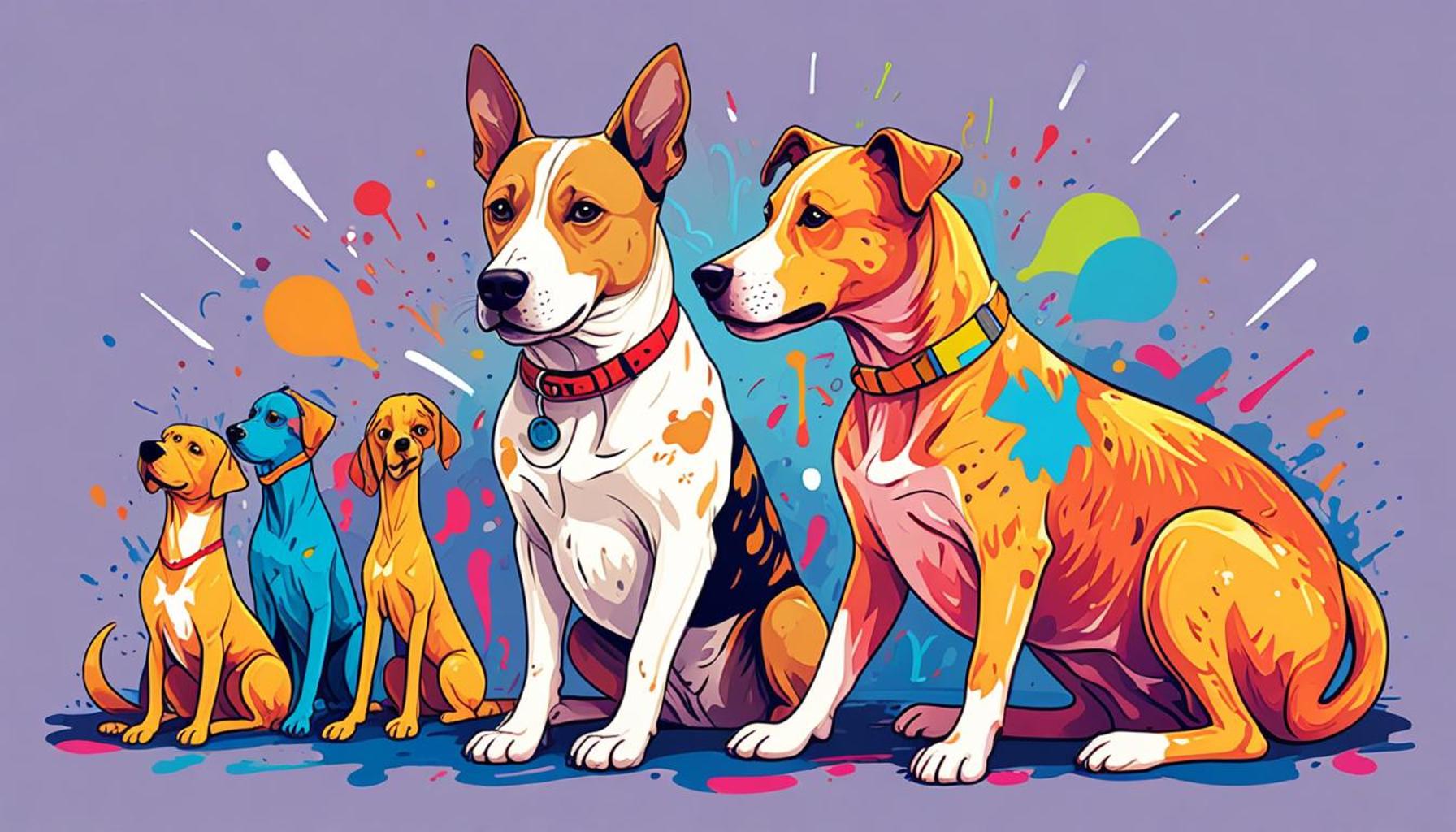Understanding Dog Body Language: Signs of Emotions and Needs

Decoding the Language of Dogs
Often viewed as our most loyal companions, dogs are animals of remarkable complexity, possessing a rich form of communication that transcends mere barks and whines. Understanding this communication is essential not only for building a solid relationship with your dog but also for ensuring a harmonious living environment for both pet and owner. The language of dogs is deeply rooted in their body language, vocalizations, and behaviors, each filled with a multitude of signals that can help us gain insight into their emotional states and needs.
Why Understanding Dog Body Language is Important:
- Prevents miscommunication that could lead to stress or aggression in both pets and their owners.
- Enhances the bond between you and your pet through better understanding and empathy.
- Promotes better training by allowing you to interpret your dog’s actions and needs accurately.
A dog’s body language can be incredibly telling. For example, a dog with a relaxed posture and wagging tail is likely content and happy. In contrast, a dog displaying tense muscles, a lowered head, or a tucked tail is communicating fear or submission. In Nigerian contexts—especially within urban settings where dogs may also serve as protectors—recognizing these signals can be pivotal. For instance, a security dog showing signs of distress might indicate a threat or discomfort in its environment, which is crucial information for its handler.
Moreover, the cultural perceptions of dogs can vary significantly, with some regions viewing them as family members while others regard them strictly as workers. It’s essential to understand that regardless of their role, dogs express their emotions in ways we must learn to interpret. For example, in many Nigerian households, where dogs may be involved in traditional festivities, observing their excitement can enhance the enjoyment of the occasion while ensuring that the dog remains comfortable and engaged rather than overwhelmed.
The journey toward deciphering your dog’s body language begins with observation. Pay close attention not just to their tail and posture, but also to their ears, eyes, and vocalizations. A dog that lifts its ears high is alert and interested, while flattened ears may suggest submission or fear. Similarly, a soft gaze can indicate trust, while wide eyes can reveal anxiety. As you enhance your understanding, both you and your dog will find greater harmony in your interactions, creating a relationship built on trust and mutual respect.

In conclusion, unraveling the canine code is not just a matter of understanding your dog; it’s an opportunity to forge a deeper connection that enriches both your life and the life of your loyal companion. By investing the time to learn their language, you are necessarily stepping into a world where empathy and communication flourish, enhancing the joy of pet ownership in ways that are both fulfilling and profound.
ADDITIONAL INSIGHTS: Expand your understanding here
Interpreting Key Body Signals
Understanding canine body language starts with recognizing the various postures and signals that your dog uses to express its emotions and needs. Dogs communicate through a sophisticated mix of signals that involve movement, positioning, and facial expressions. By carefully observing these, you can become adept at interpreting your dog’s feelings, which can lead to more responsive and caring interactions.
Postures and Positions:
- Relaxed: When a dog is at ease, it will typically exhibit a loose body, an upright but relaxed tail, and ears in a natural position. This posture suggests contentment, indicating that your pet feels safe and secure in its environment.
- Alert: Should you notice your dog standing tall with stiff legs, raised hackles, and a cocked head, these signs usually mean that your dog is attentive and possibly on guard. This is particularly important in Nigerian households where dogs are often protectors, and such behavior can indicate the presence of something or someone out of the ordinary.
- Fearful: Look out for signs like a lowered head, tucked tail, and ears pinned back. These signals reveal a state of anxiety or fear, potentially triggered by loud noises or unfamiliar environments—common in urban areas.
- Aggressive: A dog that displays aggression may stand rigid, growl, or show its teeth, coupled with a direct stare and raised hackles. Recognizing these signals is paramount to preventing potential confrontations, especially in busy public spaces.
Facial Expressions:
Much like humans, dogs have a variety of facial expressions that correlate with their emotional states. The position of their eyebrows, the tightness of their mouths, and their eye contact can tell you a great deal. For example, a dog that squints its eyes or avoids direct eye contact may be feeling uneasy or submissive. Conversely, soft eyes and a slightly open mouth usually mean a relaxed and friendly disposition.
In the Nigerian context, being aware of these signals can be particularly beneficial. Urban areas can be bustling and chaotic, which sometimes overwhelms dogs. For instance, during traditional ceremonies where a multitude of people gathers, a dog exhibiting signs of excitement may be playful, but if it starts showing signs of fear or aggression, it indicates a need for immediate attention and a calm space away from the crowds.
Ultimately, the key to a healthy relationship with your dog lies in understanding these body language cues. Being attuned to your dog’s emotions can greatly reduce the risk of miscommunication and help prevent stressful situations for both you and your pet. This unspoken connection fosters not just a pet-owner relationship, but a meaningful bond that enriches the lives of both parties.
| Emotional State | Body Language Indicators |
|---|---|
| Excitement | A dog may exhibit a rapid wagging tail, a playful stance, and even a playful bark. |
| Nervousness | Body language clues include lowered ears, tucking the tail, and avoidance behavior. |
| Aggression | A stiff posture, snarling, and direct staring indicate a dog is feeling threatened or aggressive. |
| Happiness | A relaxed body, a wagging tail, and a play bow signal that a dog is in a happy state. |
| Fear | Signs include tucked tails, flattened ears, and trembling, indicating a fear response. |
Understanding the signs of a dog’s emotions and needs is crucial for ensuring your pet’s well-being and enhancing the human-animal bond. Observing these behaviors not only helps in addressing specific needs but also fosters a deeper connection with your furry friend. By recognizing emotions such as excitement or fear through body language clues, owners can adjust their interactions to either encourage play or provide comfort. This awareness ultimately creates a positive environment that promotes trust and security, allowing the dog to flourish emotionally. Incorporating knowledge of dog body language into everyday interactions can significantly reduce misunderstandings and harmful situations. Being attentive to these signals makes you not only a better dog owner but also a more empathetic companion. As you observe your dog throughout the day, notice how their posture, movement, and energy shift in response to different stimuli, revealing their emotional landscape.
LEARN MORE: This related article may interest you
Understanding Contextual Cues
While recognizing individual body signals is crucial, understanding the context in which these signals are displayed is equally important. The setting, interactions, and even cultural backgrounds can influence a dog’s body language, so being aware of these contextual cues will further enhance your ability to interpret their emotions and needs.
Social Interactions:
Dogs are inherently social animals, and their behavior can change significantly in response to their social environment. For instance, a dog may exhibit playful behavior—such as bowing or wagging its tail—when interacting with other dogs or familiar humans. In contrast, dogs that are not used to much socialization may become withdrawn or fearful during encounters, showcasing signs like avoidance or retreating behind their owners.
In Nigerian cultures, where gatherings and communal events are common, understanding your dog’s social responses is essential. A dog that seems enthusiastic and eager to greet visitors may very well be reflecting joy, but if it begins to display signs of stress—like a tucked tail or hiding behind you—it’s a clear indication that it feels overwhelmed by the crowd.
Environmental Influences:
The environment plays a critical role in affecting a dog’s behavior. For example, a bustling marketplace in Lagos or a lively family celebration may elicit excitement in some dogs, while others may become uncomfortable. Dogs can quickly sense the high energy in these atmospheres, and their reaction will often depend on their past experiences. Veterinary clinics and other unfamiliar locations can also heighten anxiety, often resulting in a defensive posture or submissive behavior. Recognizing these environmental triggers can empower owners to take preventive measures, such as ensuring their dog has a quiet retreat in busy settings.
Emotional States:
To effectively understand your dog’s emotional state, look for clusters of signs rather than isolated behaviors. For example, a wagging tail in itself does not always indicate happiness; the dog’s overall body language should be considered. A dog with a wagging tail held high and a relaxed body is likely happy, whereas a low-hanging, rapid wagging tail coupled with tense facial features may signal uncertainty or even agitation. It’s a blending of signals that reveals the true feeling, and this often takes practice and familiarity with your pet’s natural disposition.
Moreover, dogs also express not only immediate emotions but also nuanced feelings related to experiences. For example, a dog may harbor anxiety from prior traumatic events, such as a big thunderstorm or a previous encounter with large crowds. Over time, observing your dog’s specific reactions to various stimuli can help you understand more about its unique emotional landscape.
Learning Through Interaction:
Engaging with your dog through play, training, and socialization will provide further insight into their body language. Activities such as obedience training can reveal how your dog responds to praise and correction, expanding your understanding of its emotional needs. Positive reinforcement helps to build confidence, and a confident dog will communicate much more clearly than an anxious one. This ongoing learning process enhances the bond you share, contributing to a balanced and fulfilling relationship with your canine companion.
Ultimately, taking into account the context of a dog’s body language allows for a deeper comprehension of its feelings and needs. By being observant and responsive, you can foster a nurturing environment where your dog feels understood and secure. Such a bond is essential for both their well-being and your peace of mind.
ADDITIONAL INSIGHTS: Expand your understanding here
Conclusion
Understanding a dog’s body language is a crucial skill for any dog owner, as it reveals a wealth of information about their emotions and needs. By recognizing the subtle signals, such as tail positions, ear orientation, and overall posture, we can glean insights into how our furry companions feel in various situations. The importance of context cannot be overlooked; each dog may respond differently based on their past experiences, social interactions, and environmental factors. For instance, a dog that thrives during family gatherings may require additional comfort and support in more stressful environments like crowded markets or veterinary clinics.
Moreover, dogs communicate through a language that is both simple and complex, blending various signals to convey feelings that may not be immediately obvious. This linguistic nuance encourages pet owners to observe their dogs more closely, becoming attuned to their individual personalities and emotional landscapes. Engaging with your dog through training and socialization enhances this understanding, fostering a stronger bond built on trust and awareness.
As pet owners, our responsibility is to be observant and responsive, creating a nurturing environment where our dogs feel safe and understood. By committing to this journey of learning and connection, we not only improve our pets’ well-being but also bring ourselves peace of mind. In Nigeria, where communal living is significant, fostering harmonious relationships between dogs and people can enhance the joy of shared experiences. Empathizing with and interpreting your dog’s body language is the path to a more fulfilling and reciprocal relationship—one that celebrates the love and loyalty that our dogs provide.



